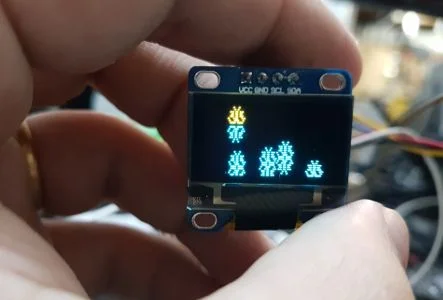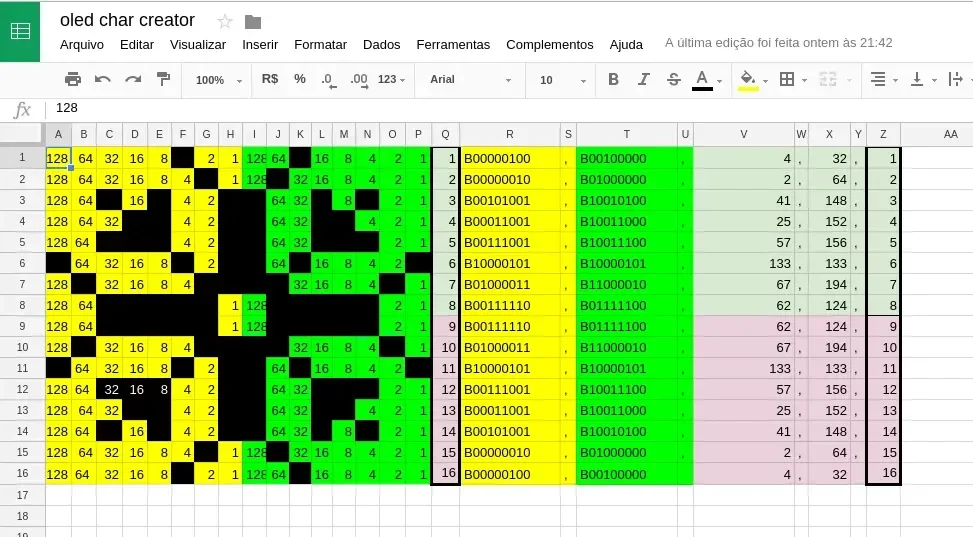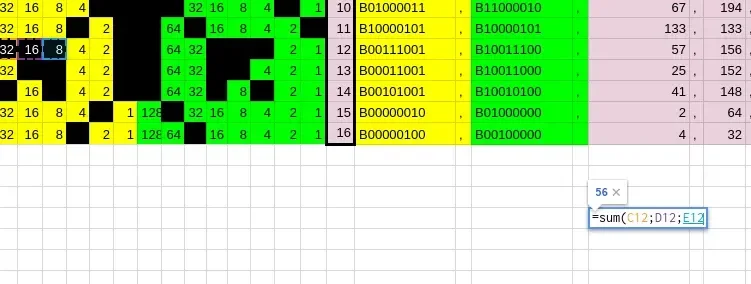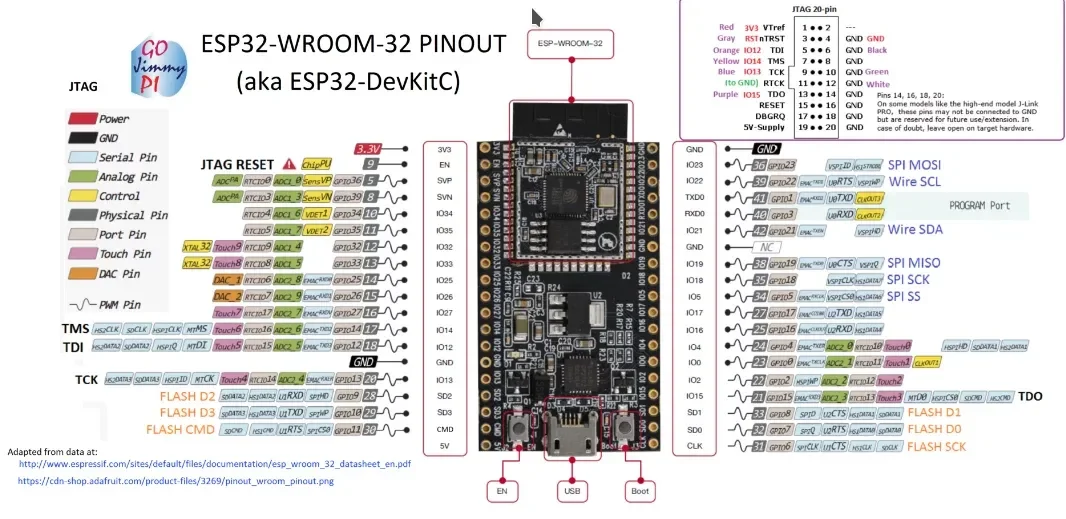Manual
do
Maker
.
com
Tema de natal com ESP32, buzzer e OLED

Natal tá chegando, hora de brincar com nossos embarcados, hum? Não comemoro natal, mas vou deixar um projetinho pra quem quiser um enfeite diferente na árvore; um tema de natal com ESP32, para tocar o "jingle bell" periodicamente.
Material
Se for para colocar em uma árvore de natal, faça emendas dos fios que vão ao 3V3 e GND. Essa é minha recomendação para minimizar o tamanho. De resto, você vai precisar de:
- 1 ESP32
- 1 buzzer que funcione em 3V3
- 1 display OLED 128x64 I2C
- 1 carregador de celular pra ligar o ESP32 longe do computador :-)
Minha recomendação é que realmente você adquira esses materiais na CurtoCircuito.
Flocos de neve para o tema de natal com ESP32
Caro leitor, não precisa amar o floco de neve, mas espero que valorize, porque deu trabalho. A parte de fazê-lo cair foi simples, porque utilizei uma biblioteca da Adafruit que já continha a função para o feito, mas desenhar o floco de neve me obrigou a aprender algumas coisas de planilha de cálculo. Utilizei o Google spreadsheet, não sei dizer o quão bom é, mas atendeu muito bem ao propósito.

O array do desenho é composto por 2 Bytes (separei em verde e amarelo). Cada Byte é composto por 8 bits, cujo bit representa 1 pixel. Se você não conhece base binária, seria bom dar uma estudada, mas basicamente os bits são lidos da direita para a esquerda, cada um com o seguinte valor:
| 7² | 6² | 5² | 4² | 3² | 2² | 1² | 0² |
| 128 | 64 | 32 | 16 | 8 | 4 | 2 | 1 |
Então o que fiz foi copiar e colar cada um dos valores em sua respectiva coluna. Parece trabalhoso, mas foi rápido.
A segunda parte foi criar mais duas colunas, cada uma representando 1 Byte. Daí soma-se os bits em preto e têm-se o valor do respectivo Byte. Para ficar visualmente compreensível, coloquei uma coluna no meio, que a partir das colunas da direita, alimentam a célula com uma string representando os 8 bits, daí é só copiar e colar.

Desenhei livremente no quadrado da esquerda, pintando o fundo das células de preto. Depois para fazer a soma, cliquei em cada um dos bits em preto segurando a tecla Ctrl. Mas primeiramente escrevi na célula =sum(. Cliquei em Enter após concluir a soma. No exemplo da imagem acima eu somei os valores que estão com os números brancos sobre fundo preto.
Se você resolver fazer desenhos assimétricos, terá que mudar a metade de baixo das últimas duas colunas porque eu espelhei para economizar tempo.
Para converter para texto foi um pouco mais complicado, mas nem precisei procurar online, foi só caçar nas funções da planilha:

Quando terminei, selecionei e colei no código dentro do array vazio:
static const unsigned char PROGMEM snowFlake[] =
{
B00000100 , B00100000 ,
B00000010 , B01000000 ,
B00101001 , B10010100 ,
B00011001 , B10011000 ,
B00111001 , B10011100 ,
B10000101 , B10000101 ,
B01000011 , B11000010 ,
B00111110 , B01111100 ,
B00111110 , B01111100 ,
B01000011 , B11000010 ,
B10000101 , B10000101 ,
B00111001 , B10011100 ,
B00011001 , B10011000 ,
B00101001 , B10010100 ,
B00000010 , B01000000 ,
B00000100 , B00100000
};
Resolvida a primeira etapa, comecei a escrever o código da música Jingle bell. Essa música é bastante simples de escrever porque o compasso é 4/4 e dá pra simplificar a divisão das notas, o que poupa tempo na hora de colocar no código. Se quiser aproveitar o piano online para criar outras músicas, eis o link.
Download da planilha do tema de natal com ESP32
Se quiser baixar a planilha para produzir seus desenhos, pegue-a no grupo Manual do Maker no facebook. Não precisa ter Office instalado, ou qualquer outra suite, apenas envie para o Google Drive e então edite-a por lá mesmo.
Juntando música e animação
Bem, aqui eu fiz apenas um exemplo, executando 2 tasks no núcleo 0 do ESP32. Se não leu os artigos anteriores relacionados ao ESP32 e o FreeRTOS, sugiro que clique alí em cima no menu ESP32 e leia um pouco sobre os recursos que você não encontra no Arduino e que sem eles, não seria possível fazer esse projeto.
Como é exemplo, adicionei as tasks no setup, mas se você quiser enfeitar sua árvore de natal com o ESP32 + display OLED + buzzer, sugiro que coloque um relógio no display e execute as tarefas uma vez por hora, como se fosse um relógio cuco. Se optar por essa sugestão, lembre-se de mudar o loop da função snowFlake para executar tanto tempo quanto durar a música, ou um pouco mais. Além disso, quando sair do loop, não se esqueça de adicionar ao final da função o vTaskDelete(NULL) para que a tarefa seja excluida. Esses conceitos estão bem explicados nos artigos anteriores relacionados ao ESP32.
Código
O código ficou um pouco longo, mas é por causa dos define e das notas, que foram tocadas uma a uma dentro da task jingleBell. Experimente apagar os define e a música para ver, não tem nenhuma complexidade na implementação.
#include <SPI.h>
#include <Wire.h>
#include <Adafruit_GFX.h>
#include <Adafruit_SSD1306.h>
#define LOGO16_GLCD_HEIGHT 16
#define LOGO16_GLCD_WIDTH 16
#define OLED_RESET 4
Adafruit_SSD1306 display(OLED_RESET);
#define NUMFLAKES 5
#define XPOS 0
#define YPOS 1
#define DELTAY 2
//Notas musicais
#define NOTE_B0 31
#define NOTE_C1 33
#define NOTE_CS1 35
#define NOTE_D1 37
#define NOTE_DS1 39
#define NOTE_E1 41
#define NOTE_F1 44
#define NOTE_FS1 46
#define NOTE_G1 49
#define NOTE_GS1 52
#define NOTE_A1 55
#define NOTE_AS1 58
#define NOTE_B1 62
#define NOTE_C2 65
#define NOTE_CS2 69
#define NOTE_D2 73
#define NOTE_DS2 78
#define NOTE_E2 82
#define NOTE_F2 87
#define NOTE_FS2 93
#define NOTE_G2 98
#define NOTE_GS2 104
#define NOTE_A2 110
#define NOTE_AS2 117
#define NOTE_B2 123
#define NOTE_C3 131
#define NOTE_CS3 139
#define NOTE_D3 147
#define NOTE_DS3 156
#define NOTE_E3 165
#define NOTE_F3 175
#define NOTE_FS3 185
#define NOTE_G3 196
#define NOTE_GS3 208
#define NOTE_A3 220
#define NOTE_AS3 233
#define NOTE_B3 247
#define NOTE_C4 262
#define NOTE_CS4 277
#define NOTE_D4 294
#define NOTE_DS4 311
#define NOTE_E4 330
#define NOTE_F4 349
#define NOTE_FS4 370
#define NOTE_G4 392
#define NOTE_GS4 415
#define NOTE_A4 440
#define NOTE_AS4 466
#define NOTE_B4 494
#define NOTE_C5 523
#define NOTE_CS5 554
#define NOTE_D5 587
#define NOTE_DS5 622
#define NOTE_E5 659
#define NOTE_F5 698
#define NOTE_FS5 740
#define NOTE_G5 784
#define NOTE_GS5 831
#define NOTE_A5 880
#define NOTE_AS5 932
#define NOTE_B5 988
#define NOTE_C6 1047
#define NOTE_CS6 1109
#define NOTE_D6 1175
#define NOTE_DS6 1245
#define NOTE_E6 1319
#define NOTE_F6 1397
#define NOTE_FS6 1480
#define NOTE_G6 1568
#define NOTE_GS6 1661
#define NOTE_A6 1760
#define NOTE_AS6 1865
#define NOTE_B6 1976
#define NOTE_C7 2093
#define NOTE_CS7 2217
#define NOTE_D7 2349
#define NOTE_DS7 2489
#define NOTE_E7 2637
#define NOTE_F7 2794
#define NOTE_FS7 2960
#define NOTE_G7 3136
#define NOTE_GS7 3322
#define NOTE_A7 3520
#define NOTE_AS7 3729
#define NOTE_B7 3951
#define NOTE_C8 4186
#define NOTE_CS8 4435
#define NOTE_D8 4699
#define NOTE_DS8 4978
//tempo
#define WHOLE 500
#define HALF 250
#define QUARTER 125
#define EIGHTH 62.5
#define SIXTEENTH 31.25
#define CHANELL 0
#define FREQUENCE 2000
#define RESOLUTION 10
#define BUZZER_PIN GPIO_NUM_15
static const unsigned char PROGMEM snowFlake[] =
{
B00000100 , B00100000 ,
B00000010 , B01000000 ,
B00101001 , B10010100 ,
B00011001 , B10011000 ,
B00111001 , B10011100 ,
B10000101 , B10000101 ,
B01000011 , B11000010 ,
B00111110 , B01111100 ,
B00111110 , B01111100 ,
B01000011 , B11000010 ,
B10000101 , B10000101 ,
B00111001 , B10011100 ,
B00011001 , B10011000 ,
B00101001 , B10010100 ,
B00000010 , B01000000 ,
B00000100 , B00100000
};
#if (SSD1306_LCDHEIGHT != 32)
#error("Height incorrect, please fix Adafruit_SSD1306.h!");
#endif
void jingleBell(void *pvParameters){
for (byte i=0;i<2;i++){
ledcWriteTone(CHANELL,NOTE_C4);
delay(HALF);
ledcWriteTone(CHANELL,NOTE_C4);
delay(HALF);
ledcWriteTone(CHANELL,NOTE_A4);
delay(HALF);
ledcWriteTone(CHANELL,NOTE_G4);
delay(HALF);
ledcWriteTone(CHANELL,NOTE_F4);
delay(HALF);
ledcWriteTone(CHANELL,NOTE_C4);
delay(WHOLE+HALF);
ledcWriteTone(CHANELL,NOTE_C4);
delay(HALF);
ledcWriteTone(CHANELL,NOTE_C4);
delay(HALF);
ledcWriteTone(CHANELL,NOTE_A4);
delay(HALF);
ledcWriteTone(CHANELL,NOTE_G4);
delay(HALF);
ledcWriteTone(CHANELL,NOTE_F4);
delay(HALF);
ledcWriteTone(CHANELL,NOTE_D4);
delay(WHOLE+HALF);
ledcWriteTone(CHANELL,NOTE_D4);
delay(HALF);
ledcWriteTone(CHANELL,NOTE_D4);
delay(HALF);
ledcWriteTone(CHANELL,NOTE_AS4);
delay(HALF);
ledcWriteTone(CHANELL,NOTE_A4);
delay(HALF);
ledcWriteTone(CHANELL,NOTE_G4);
delay(HALF);
if (i == 0){
ledcWriteTone(CHANELL,NOTE_E4);
delay(WHOLE+HALF);
}
else{
ledcWriteTone(CHANELL,NOTE_C5);
delay(WHOLE+HALF);
}
if (i == 0){
ledcWriteTone(CHANELL,NOTE_C5);
delay(HALF);
ledcWriteTone(CHANELL,NOTE_D5);
delay(HALF);
ledcWriteTone(CHANELL,NOTE_C5);
delay(HALF);
ledcWriteTone(CHANELL,NOTE_G4);
delay(HALF);
ledcWriteTone(CHANELL,NOTE_GS4);
delay(HALF);
ledcWriteTone(CHANELL,NOTE_A4);
delay(WHOLE+HALF);
}
else{
ledcWriteTone(CHANELL,NOTE_C5);
delay(HALF);
ledcWriteTone(CHANELL,NOTE_D5);
delay(HALF);
ledcWriteTone(CHANELL,NOTE_C5);
delay(HALF);
ledcWriteTone(CHANELL,NOTE_AS4);
delay(HALF);
ledcWriteTone(CHANELL,NOTE_G4);
delay(HALF);
ledcWriteTone(CHANELL,NOTE_F4);
delay(WHOLE+HALF);
}
delay(100);
}
ledcWriteTone(CHANELL, 0);
delay(125);
for (byte i = 0; i<2;i++){
ledcWriteTone(CHANELL,NOTE_A4);
delay(HALF);
ledcWriteTone(CHANELL, 0);
ledcWriteTone(CHANELL,NOTE_A4);
delay(HALF);
ledcWriteTone(CHANELL, 0);
ledcWriteTone(CHANELL,NOTE_A4);
delay(HALF);
ledcWriteTone(CHANELL, 0);
ledcWriteTone(CHANELL,NOTE_A4);
delay(HALF);
ledcWriteTone(CHANELL, 0);
delay(25);
}
ledcWriteTone(CHANELL,NOTE_A4);
delay(HALF);
ledcWriteTone(CHANELL,NOTE_C5);
delay(HALF);
ledcWriteTone(CHANELL,NOTE_F4);
delay(HALF);
ledcWriteTone(CHANELL,NOTE_G4);
delay(HALF);
ledcWriteTone(CHANELL,NOTE_A4);
delay(HALF+WHOLE);
ledcWriteTone(CHANELL, 0);
delay(25);
ledcWriteTone(CHANELL, 0);
ledcWriteTone(CHANELL,NOTE_AS4);
delay(HALF);
ledcWriteTone(CHANELL, 0);
ledcWriteTone(CHANELL,NOTE_AS4);
delay(HALF);
ledcWriteTone(CHANELL, 0);
ledcWriteTone(CHANELL,NOTE_AS4);
delay(WHOLE);
delay(25);
ledcWriteTone(CHANELL, 0);
ledcWriteTone(CHANELL,NOTE_AS4);
delay(HALF);
ledcWriteTone(CHANELL, 0);
ledcWriteTone(CHANELL,NOTE_A4);
delay(HALF);
ledcWriteTone(CHANELL, 0);
ledcWriteTone(CHANELL,NOTE_A4);
delay(WHOLE);
ledcWriteTone(CHANELL, 0);
ledcWriteTone(CHANELL,NOTE_G4);
delay(HALF);
ledcWriteTone(CHANELL,NOTE_A4);
delay(HALF);
ledcWriteTone(CHANELL,NOTE_G4);
delay(HALF);
ledcWriteTone(CHANELL,NOTE_A4);
delay(HALF);
ledcWriteTone(CHANELL,NOTE_G4);
delay(HALF);
ledcWriteTone(CHANELL,NOTE_C5);
delay(HALF+WHOLE);
ledcWriteTone(CHANELL, 0);
delay(25);
for (byte i = 0; i<2;i++){
ledcWriteTone(CHANELL,NOTE_A4);
delay(HALF);
ledcWriteTone(CHANELL, 0);
ledcWriteTone(CHANELL,NOTE_A4);
delay(HALF);
ledcWriteTone(CHANELL, 0);
ledcWriteTone(CHANELL,NOTE_A4);
delay(HALF);
ledcWriteTone(CHANELL, 0);
ledcWriteTone(CHANELL,NOTE_A4);
delay(HALF);
ledcWriteTone(CHANELL, 0);
delay(25);
}
ledcWriteTone(CHANELL,NOTE_A4);
delay(HALF);
ledcWriteTone(CHANELL,NOTE_C5);
delay(HALF);
ledcWriteTone(CHANELL,NOTE_F4);
delay(HALF);
ledcWriteTone(CHANELL,NOTE_G4);
delay(HALF);
ledcWriteTone(CHANELL,NOTE_A4);
delay(WHOLE+WHOLE);
ledcWriteTone(CHANELL, 0);
delay(25);
ledcWriteTone(CHANELL, 0);
ledcWriteTone(CHANELL,NOTE_AS4);
delay(HALF);
ledcWriteTone(CHANELL, 0);
ledcWriteTone(CHANELL,NOTE_AS4);
delay(HALF);
ledcWriteTone(CHANELL, 0);
ledcWriteTone(CHANELL,NOTE_AS4);
delay(WHOLE);
delay(25);
ledcWriteTone(CHANELL, 0);
ledcWriteTone(CHANELL,NOTE_AS4);
delay(HALF);
ledcWriteTone(CHANELL, 0);
ledcWriteTone(CHANELL,NOTE_A4);
delay(HALF);
ledcWriteTone(CHANELL, 0);
ledcWriteTone(CHANELL,NOTE_A4);
delay(WHOLE);
ledcWriteTone(CHANELL,NOTE_C5);
delay(HALF);
ledcWriteTone(CHANELL,NOTE_C5);
delay(HALF);
ledcWriteTone(CHANELL,NOTE_AS4);
delay(HALF);
ledcWriteTone(CHANELL,NOTE_G4);
delay(HALF);
ledcWriteTone(CHANELL,NOTE_F4);
delay(HALF+WHOLE);
ledcWriteTone(CHANELL, 0);
vTaskDelete(NULL);
}
void testdrawbitmap(const uint8_t *bitmap, uint8_t w, uint8_t h) {
uint8_t icons[NUMFLAKES][3];
// initialize
for (uint8_t f=0; f< NUMFLAKES; f++) {
icons[f][XPOS] = random(display.width());
icons[f][YPOS] = 0;
icons[f][DELTAY] = random(5) + 1;
Serial.print("x: ");
Serial.print(icons[f][XPOS], DEC);
Serial.print(" y: ");
Serial.print(icons[f][YPOS], DEC);
Serial.print(" dy: ");
Serial.println(icons[f][DELTAY], DEC);
}
while (1) {
// draw each icon
for (uint8_t f=0; f< NUMFLAKES; f++) {
display.drawBitmap(icons[f][XPOS], icons[f][YPOS], bitmap, w, h, WHITE);
}
display.display();
delay(200);
// then erase it + move it
for (uint8_t f=0; f< NUMFLAKES; f++) {
display.drawBitmap(icons[f][XPOS], icons[f][YPOS], bitmap, w, h, BLACK);
// move it
icons[f][YPOS] += icons[f][DELTAY];
// if its gone, reinit
if (icons[f][YPOS] > display.height()) {
icons[f][XPOS] = random(display.width());
icons[f][YPOS] = 0;
icons[f][DELTAY] = random(5) + 1;
}
}
}
}
void playSnow(void *pvParameters){
//snow flakes
testdrawbitmap(snowFlake, LOGO16_GLCD_HEIGHT, LOGO16_GLCD_WIDTH);
}
void setup() {
Serial.begin(115200);
display.begin(SSD1306_SWITCHCAPVCC, 0x3C);
//display.display();
delay(2000);
display.clearDisplay();
// invert the display
display.invertDisplay(true);
delay(1000);
display.invertDisplay(false);
delay(1000);
display.clearDisplay();
gpio_set_direction(BUZZER_PIN,GPIO_MODE_INPUT);
ledcSetup(CHANELL, FREQUENCE, RESOLUTION);
ledcAttachPin(BUZZER_PIN, CHANELL);
xTaskCreatePinnedToCore(jingleBell,"jingleBell",8192,NULL,10,NULL,0);
xTaskCreatePinnedToCore(playSnow,"playSnow",8192,NULL,10,NULL,0);
}
void loop() {
// put your main code here, to run repeatedly:
}
Do jeito que está disposto o código, logo que subí-lo pela IDE do Arduino, as duas tasks serão executadas e ao término da música, os flocos de neve continuarão a cair.
Wiring
Coloque o ESP32 com a USB para baixo. Do lado direito, no pino 4 de baixo para cima, coloque o GND do buzzer. A outra perna do buzzer, alimente no 3V3. O Display é I2C, também alimentado em 3V3. Além da alimentação e GND, você deve conectar os pinos SDA ao SDA e SCL ao SCL, mas nada. Eis o pinout do ESP32:

Video
Agora a demonstração do tema de natal com ESP32, espero que goste e compartilhe nas redes sociais!
Inscreva-se no nosso canal Manual do Maker no YouTube.
Também estamos no Instagram.

Djames Suhanko
Autor do blog "Do bit Ao Byte / Manual do Maker".
Viciado em embarcados desde 2006.
LinuxUser 158.760, desde 1997.